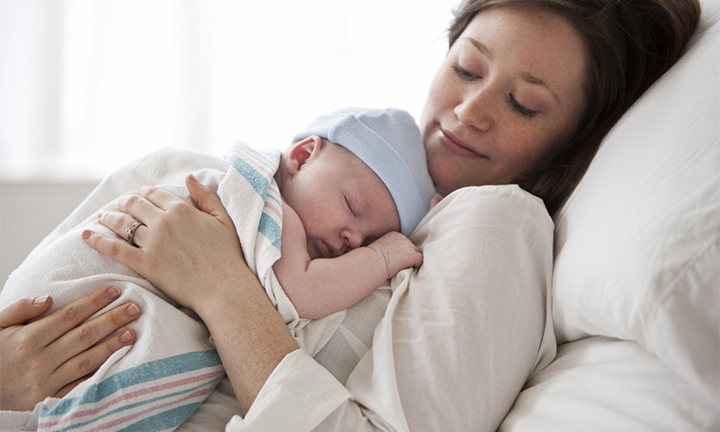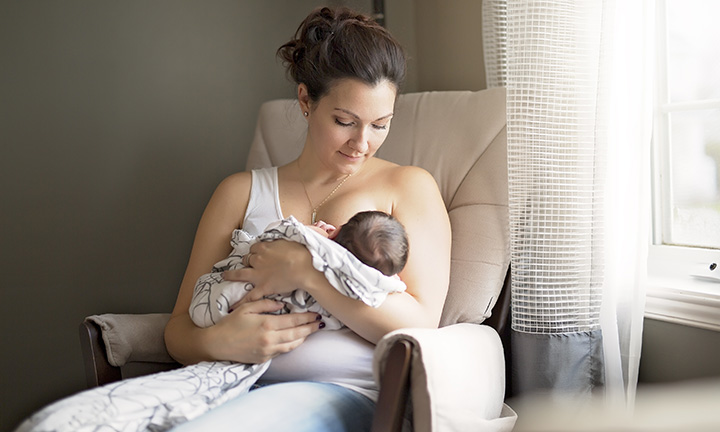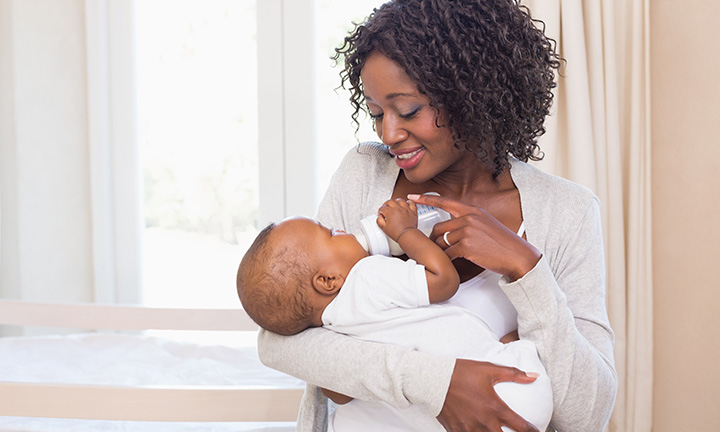
Sore, Cracked, or Bleeding Nipples While Breastfeeding
Sore, cracked, chapped, scabbed, and/or bleeding nipples are something you may experience while breastfeeding. It takes time for you and your baby to acclimate to this new experience, so soreness tends to be strongest in the beginning, subsiding as you continue to breastfeed. But what about other symptoms? Learn why sore, scabbed, and chapped nipples occur when breastfeeding, what you can do about them, what happens when they’re cracked with fissures and/or bleeding, and more.
What Are Sore, Cracked, Scabbed, and Chapped Nipples?
Why does breastfeeding hurt sometimes? You’re definitely not the only one asking this question! We have plenty of helpful and reassuring advice on breastfeeding in general, and in this article, we’ll tackle some of the challenges that can crop up, such as nipple pain and soreness, cracked nipples vs. chapped nipples, and more. In this section in particular, we’ll identify the different types of nipple pain that may occur alongside breastfeeding.
Sore, Tender, Painful Nipples
Nipple soreness while breastfeeding or after a feeding is quite common, especially when you’re just getting started. You’ll likely feel these symptoms, not always see them. Of course, specific sensations can vary from person to person, but it’s possible to experience any of the following:
In some cases, visible signs do occur. You may notice redness along with nipple sensitivity or even experience swollen nipples while breastfeeding.
Chapped Nipples
Breastfeeding and pumping can sometimes lead to chapped nipples—nipples that are rough, reddened, and slightly cracked. During nursing or pumping, the skin can become irritated and then chapped from the constant chafing involved in these actions.
Cracked, Scabbed, Bleeding Nipples and Nipple Fissures
Nipple pain while breastfeeding can also accompany cracks or tears to the skin or even some bleeding. Cracked nipples during breastfeeding are an indication that there’s too much strain on the nipple tissue, which can leave your nipples vulnerable to infection, bleeding, and scabbing. Nipple fissures are another term for painful, cracked nipples, referring to the sore tears that may occur after breastfeeding.
Cracked nipples have a few symptoms, and may look red and dry, often at the tip. Nipples can also appear flaky and crusty when breastfeeding, and the nipple fissures may have scabs on them as they heal. Additionally, you might feel pain or soreness, plus general irritation or itchiness.
What Causes Nipple Pain While Breastfeeding?
The most common reason for any of the listed issues above is improper latching when first starting breastfeeding, with symptoms typically appearing during the first few days or weeks of nursing.
Latching has to do with how your baby is positioned when breastfeeding and how they suck on the nipple. If your baby’s mouth doesn’t cover enough of the areola, the darkened area of skin that surrounds the nipple, your little one will suck more forcefully on your nipple. So, if you're wondering “Why does my nipple hurt when breastfeeding?” the answer could be poor latching.
Nipple Pain After a Bad Latch
After a bad latch, your nipples might be sore, chapped, or scabbed. Again, this most often occurs when you first start to breastfeed, as you and your baby get used to the process. Statistically, 80 to 90 percent of breastfeeding parents experience nipple pain, including nipple fissures, so you’re not alone if you’re also experiencing these symptoms.
If your nipples hurt when breastfeeding, take a look at proper positioning and latching:
You’ll know your baby has a proper latch if their gums and lips form a “seal” over your nipple, covering a large portion (about one to two inches) of the areola. An asymmetrical latch is best, with more of your areola covered by your baby’s lower lip and a little bit less in the upper lip.
Nipple Pain After a Good Latch
It’s possible that your nipple still hurts even with a good latch while breastfeeding. This could be due to skin-on-skin friction. But if you have a sharp pain in your nipple while breastfeeding, such as a pain that shoots or burns throughout your breast, this could be spasms of the blood vessels. In that case, a heating pad or warm gel pack can provide relief. Of course, contact your healthcare provider if this happens often or if the pain is difficult to tolerate.
Other Causes of Sore, Cracked Nipples After Breastfeeding
You can also experience sore, tender, chapped, cracked, and bleeding nipples if you have engorged breasts. During pregnancy or when breastfeeding, you might overproduce milk, causing your nipple tissue to possibly stretch and crack.
If you use a breast pump, nipple pain and nipple fissures can occur if the suction settings are too high or if you use the wrong size breast shields. Be sure to contact your healthcare provider or a lactation consultant for help with these issues.
How Long Does Nipple Pain Last When Breastfeeding?
Sore nipples, or nipples that are painful, tender, chapped, or cracked, tend to get better after the first month of breastfeeding. These initial weeks are when you and your baby are getting used to the process and learning how to achieve a good latch.
If you have a cracked nipple with a nipple fissure, especially one that’s also bleeding, it can take a few days or even a few weeks to heal.
How to Relieve and Treat Sore Nipples When Breastfeeding
The best way to keep your nipples from cracking, chapping, and bleeding while breastfeeding is to help your baby properly latch. Once your little one gets the hang of it, your nipples will likely feel less painful, tender, and sore. An asymmetrical latch, in particular, can help protect the nipple. If you need any help or guidance on how to latch properly, you can contact your healthcare provider or a lactation consultant.
But it might take a little time to get to a good latch, so in the meantime, you can consider some other remedies. Below are a few treatment options for cracked nipples (nipple fissures) plus nipples that are sore, tender, painful, and chapped.
If sore nipples are due to an infection, such as thrush or mastitis, or if you develop an infection from cracked nipples while breastfeeding, your healthcare provider may prescribe antibiotics. Always consult your healthcare provider before starting any treatment.
When to Contact Your Healthcare Provider
You should contact your healthcare provider regarding sore or cracked nipples when breastfeeding if:
Can You Still Breastfeed With Cracked Nipples (Nipple Fissures)?
If you’re able to solve the issue of pain or soreness by repositioning your baby and getting a proper latch, then you can still breastfeed, even with cracked nipples and even if they’re bleeding or have fissures. With that being said, if the cracks or soreness are causing too much pain, you might want to give your nipples a break. You can do so by simply expressing or pumping for a few days instead of breastfeeding.
FAQS AT A GLANCE
It depends on the extent of the wound, but generally speaking, it could take anywhere from a few days to a few weeks to fully heal cracked nipples.
The Bottom Line
Cracked, sore, scabbed, bleeding, and painful nipples are common when breastfeeding, but they’re not necessarily “normal.” That simply means there are ways to help reduce the chance of experiencing these symptoms, mainly ensuring your baby has a good latch when breastfeeding. Still, many breastfeeding parents will experience this soreness with cracked nipples. So, when it does occur, use the strategies in this article to find some relief, and check out our tips from a lactation consultant.
In the meantime, enjoy those tender, breastfeeding moments with your little one, and be sure to download the free Pampers Rewards app, where you can earn Pampers Cash and redeem digital offers on what every parent needs: diapers and wipes.
- American College of Obstetricians and Gynecologists. Your Pregnancy and Childbirth: Month to Month, 6th ed. (Washington, DC: American College of Obstetricians and Gynecologists, 2015).
- Cambridge Dictionary. “CHAPPED | English Meaning.”
- Cleveland Clinic. “Breast Lumps: Types, Benign, Moveable, Causes & Diagnosis.”
- Cleveland Clinic. “Chaffing: Causes and Prevention.”
- Cleveland Clinic. “Folliculitis: Appearance, Causes, Symptoms & Treatment.”
- Cleveland Clinic. “Nipple Fissures.”
- Cleveland Clinic. “Sore Nipples.”
- Cleveland Clinic. “Thrush: Symptoms, Causes & Treatment.”
- John Hopkins Medicine. “Breast Feeding: Getting Started.”
- Mayo Clinic. “Nipple Discharge.”
- The Breastfeeding Network. “Cracked Nipples and Moist Wound Healing.”
Read more about Baby
Related Articles
Join a World of Support
through Pregnancy and Parenthood.












